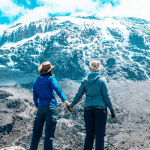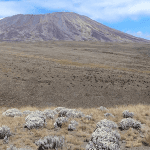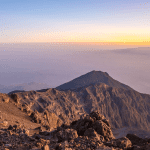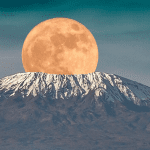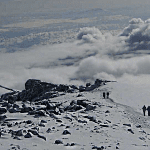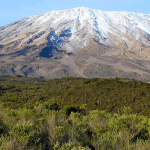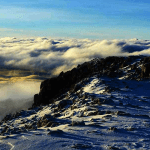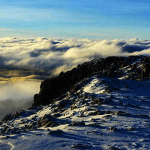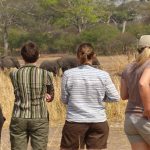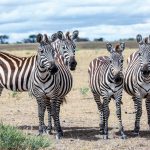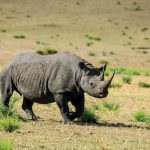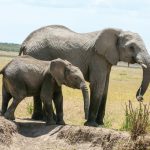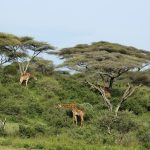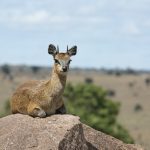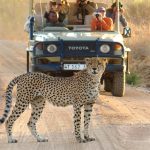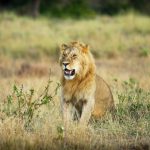Nestled in Tanzania, Kilimanjaro National Park is a captivating destination that offers a unique blend of natural beauty, cultural immersion, and adventure. This travel guide provides a comprehensive overview of what to expect when visiting this remarkable region.
From the vibrant Maasai people to the awe-inspiring landscapes, we will explore the attractions, activities, and practical information to help you make the most of your journey to the home of the Maasai people.
Getting to Kilimanjaro National Park: Your Gateway to Adventure
Getting to Kilimanjaro National Park is relatively convenient, with various transportation options. Here are some ways to reach this captivating destination:
a) Flights: The nearest international airport to West Kilimanjaro is Kilimanjaro International Airport (JRO), located approximately 40 kilometers (25 miles) east of the region. Several airlines operate flights to JRO from major cities around the world. Upon arrival, you can hire a taxi or arrange a pre-booked transfer to reach your desired destination in West Kilimanjaro.
b) Road: If you prefer a scenic road trip, you can also reach West Kilimanjaro by bus or private car from neighboring towns and cities. Arusha, a bustling city located approximately 80 kilometers (50 miles) southeast of West Kilimanjaro, is a major transportation hub and provides convenient access to the region.
Discover the Maasai People and Their Rich Culture
The Maasai people are one of Tanzania’s most iconic ethnic groups, known for their distinctive customs and traditional way of life. Engaging in a cultural exchange with the Maasai offers a glimpse into their rich heritage.
You can participate in traditional dances, visit Maasai villages, and learn about their fascinating traditions and rituals. This immersive experience allows you to understand better the region’s cultural diversity and fosters an appreciation for the local communities who call West Kilimanjaro home.
Majestic Mount Kilimanjaro: Conquer the Rooftop of Africa
The towering presence of Mount Kilimanjaro is one of the primary reasons travelers are drawn to West Kilimanjaro. Standing at 5,895 meters (19,341 feet), it is the highest mountain in Africa and a renowned challenge for climbers around the world.
Embarking on a trek to its summit is an exhilarating adventure, offering breathtaking views and a sense of accomplishment. Whether you’re an experienced mountaineer or a first-time climber, the climb Kilimanjaro adventure provides an opportunity to push your limits and experience the grandeur of this iconic peak.
Serengeti National Park: Witness the Great Migration
West Kilimanjaro is a gateway to the world-famous Serengeti National Park, a UNESCO World Site, and one of Africa’s most famous wildlife reserves. With its vast plains and diverse ecosystems, the Serengeti is home to abundant wildlife, including the renowned Big Five (lion, leopard, elephant, rhinoceros, and buffalo).
Embark on an excitingsafari adventure, witness the annual Great Migration, and capture incredible photographs of lions stalking the grasslands or elephants bathing in watering holes. The Serengeti promises an unparalleled wildlife experience that will leave you in awe.
Lush Coffee Plantations: Delve into the World of Arabica Coffee
West Kilimanjaro is famous for its luxuriant coffee plantations that produce some of the finest Arabica coffee in the world. Take a tour of these plantations and delve into the process of coffee cultivation, from bean to cup.
Learn about the different varieties of coffee, witness the harvesting and roasting processes, and savor the decadent aromas and flavors of freshly brewed coffee. A coffee tour offers a unique opportunity to connect with the local farmers, gain insights into their livelihoods, and enjoy a sensory experience that will delight coffee enthusiasts.
Visit Kilimanjaro National Park
Dive into the awe-inspiring beauty of the Kilimanjaro National Park ecosystem, a captivating destination in northern Tanzania’s vibrant region. The park’s ecological richness is expressed through its varying altitudes that nurture distinct habitats, from lush montane forests teeming with wildlife to the arctic conditions of the snow-capped summit.
Exploring this pride of Tanzania may lead you through cloud-draped rainforests across exotic heath and moorlands and up to alpine deserts, spotting rare, endemic species. Such stunning biodiversity makes Kilimanjaro National Park a prominent part of any Tanzanian Safari, offering an immersive experience of Africa’s mesmerizing landscapes.
Unveil the wonders of northern Tanzania – embark on the journey of a lifetime to the Kilimanjaro National Park.
Adventure Sports and Outdoor Activities: Thrills and Tranquility
West Kilimanjaro, the gateway to Africa’s tallest mountain, is a haven for outdoor enthusiasts and adventure-seekers. Here, you can embark on an exhilarating mountain biking adventure across the rugged terrain and test your endurance with a dose of mountain climbing on Mount Kilimanjaro’s majestic slopes, the crown jewel of any Tanzanian Safari.
If you thirst for thrill, gear up for a heart-pumping quad bike safari along the region’s winding paths or experience the frothy fury of white-water rafting on its mighty rivers. For those seeking a calm yet captivating endeavor, mount a horse and meander your way through the picturesque landscapes, amazed by the breathtaking views of Mount Kilimanjaro, standing proud as Africa’s tallest mountain.
Whether it’s the adrenaline that lures you or the serene beauty of the Tanzanian highlands, West Kilimanjaro caters to every kind of adventurer, promising experiences of a lifetime.
Accommodation Options in Mount Kilimanjaro National Park: Where to Stay
Kilimanjaro National Park offers various accommodations for every traveler’s preferences and budget. From luxury lodges to cozy guesthouses, you’ll find a place to relax and rejuvenate after your adventures.
Some popular accommodation choices include:
Kilimanjaro National Park Safari Lodges
Experience the ultimate luxury in West Kilimanjaro at one of the exquisite safari lodges. These lodges provide comfortable rooms, exceptional service, and stunning views of the surrounding wilderness.
Many lodges also offer guided safari tours and other activities to enhance your wildlife experience.
Kilimanjaro National Park Tented Camps
Consider staying in a tented camp for a more immersive and adventurous experience. These camps provide a unique opportunity to connect with nature while enjoying the comforts of a cozy bed and essential amenities.
Wake up to the sounds of the wilderness and witness the beauty of the starry night sky from the comfort of your tent.
Kilimanjaro National Park Guesthouses and Homestays
Suppose you prefer a more authentic and budget-friendly option. In that case, guesthouses and homestays in West Kilimanjaro offer a chance to connect with the local communities and experience the warm hospitality of the Maasai people.
These accommodations provide a glimpse into the daily lives of the locals and offer a unique cultural exchange opportunity.
Exploring Kilimanjaro National Park: Recommended Itineraries
When preparing your trip to West Kilimanjaro, plan to explore its scenic beauty with well-planned itineraries for a Kilimanjaro park safari. Consider spending a few days to immerse in its rich wildlife viewing experiences.
Remember to set aside time to visit the indigenous Maasai villages. Lastly, visit surrounding coffee plantations to discover their unique process.
Maasai Cultural Immersion
Embark on a cultural journey by dedicating a few days to immersing yourself in the vibrant Maasai culture. Participate in traditional dances that weave together stories of the Maasai people, visit their villages to gain firsthand insights into their way of life, and engage in enlightening conversations to learn about their customs and age-old traditions.
The immersive experience allows you to forge meaningful connections with the Maasai community, fostering a deeper appreciation for their unique heritage. Complementing this cultural exploration, venture into the region’s lush landscapes and visit coffee plantations.
Delve into the intricacies of coffee production, from cultivation to harvesting and processing. Knowledgeable guides will walk you through the entire coffee-making journey, offering fascinating insights into the art and science behind this beloved beverage.
Conclude your visit with aromatic coffee-tasting sessions, allowing you to savor the rich flavors and aromas of freshly brewed coffee while surrounded by the picturesque beauty of the plantations. This well-rounded experience seamlessly blends cultural immersion with the exploration of local agriculture, creating lasting memories and a deeper understanding of the diverse facets of the region.
Mount Kilimanjaro Adventure
Venture on an exhilarating adventure as you set your sights on conquering the roof of Africa – Mount Kilimanjaro. The journey involves meticulous planning for a multi-day trek, ascending to the summit through one of the established routes under the expert guidance of experienced mountain guides. These seasoned guides ensure a safe and successful ascent, offering valuable insights into the terrain and providing support throughout the trek.
As you ascend along the various Kilimanjaro routes, immerse yourself in Tanzania’s ever-changing and breathtaking landscapes. From lush montane forests to alpine meadows and stark volcanic terrain, a Tanzania safari boasts an unforgettable journey.
The trek to Mount Kilimanjaro’s summit is not only a physical challenge but also a mental one, pushing your limits and testing your resilience against the changing altitudes and climates. During your expedition, the opportunity to experience a remarkable Tanzania safari or explore the diverse Kilimanjaro routes only adds to the extraordinary adventure.
Reaching the highest point on the African continent is a monumental achievement, rewarding you with awe-inspiring panoramic views, an overwhelming sense of accomplishment, and a deeper connection to the natural world. The journey to the summit of Mount Kilimanjaro is not just a trek; it’s a transformative experience that demands determination, perseverance, and a profound bond with this iconic peak.
Serengeti Safari Experience
Elevate your travel experience by seamlessly merging your exploration of West Kilimanjaro with an exhilarating safari adventure in the renowned Serengeti National Park. Extend the horizons of your journey beyond the captivating landscapes of West Kilimanjaro as you embark on a meticulously guided safari tour through the vast and diverse terrains of the Serengeti.
Immerse yourself in the heart of the wild, where each moment brings you face-to-face with the region’s extraordinary biodiversity. Witness the awe-inspiring majesty of the Big Five – lions, elephants, buffaloes, leopards, and rhinoceros – as they roam freely in their natural habitat.
The Serengeti is also home to the renowned Great Migration, a remarkable spectacle where massive herds of wildebeest, zebras, and other herbivores traverse the plains in search of greener pastures. Your guided safari unfolds a tapestry of natural wonders, allowing you to capture unforgettable moments with your camera or savor the breathtaking scenes with your own eyes.
The synergy of West Kilimanjaro’s unique charm and the riveting wildlife encounters in the Serengeti creates an unparalleled adventure. This ensures that the memories forged during this combined exploration will be in your heart forever.
Conclusion
With its vibrant Maasai culture, majestic Mount Kilimanjaro, the incredible Serengeti National Park, lush coffee plantations, and an array of adventure sports, West Kilimanjaro is an unparalleled destination for travelers in 2023/2024.
Whether seeking awe-inspiring natural landscapes, thrilling outdoor activities, or immersing yourself in vibrant local cultures, West Kilimanjaro offers an enriching and unforgettable experience. Start planning your journey to this remarkable destination and prepare to be captivated by the wonders that await you in West Kilimanjaro.
FAQs
What is the best time to climb Mount Kilimanjaro?
For an optimal Mount Kilimanjaro climbing experience, it is advisable to plan your expedition during the dry seasons, which generally extend from late June to October and from late December to early March. These periods boast favorable weather conditions characterized by clear skies, enhanced visibility, and more stable trekking conditions.
The absence of heavy rainfall during these times reduces the risk of slippery and challenging trails, creating a more conducive environment for a successful ascent. The dry seasons also provide a more enjoyable overall experience, allowing climbers to marvel at the stunning landscapes and panoramic views along the ascent.
Choosing to climb during these windows not only increases the likelihood of reaching the summit but also ensures that you can fully appreciate the awe-inspiring beauty of Mount Kilimanjaro without the hindrance of adverse weather conditions.
How challenging is the climb to the summit of Mount Kilimanjaro?
Climbing Mount Kilimanjaro is an inherently challenging undertaking, primarily due to the significant altitude and the potential for altitude-related symptoms. Success relies on physical fitness, mental resilience, and careful acclimatization.
Selecting an appropriate route and allowing ample time for acclimatization breaks are vital components for a safe and successful ascent. Careful consideration of the chosen route is crucial, as each presents unique challenges and vistas.
Balancing physical exertion with gradual acclimatization helps mitigate the risks associated with higher altitudes. By prioritizing these factors and maintaining open communication with guides, climbers can enhance their chances of a safe and rewarding summit experience on Mount Kilimanjaro.
Do I need to hire a guide for climbing Mount Kilimanjaro?
Securing the services of a guide is not just a recommendation but a mandatory requirement when embarking on the ascent of Mount Kilimanjaro. The stringent park regulations dictate that all climbers must be accompanied by a certified guide throughout their journey.
These guides play a pivotal role in ensuring the safety and well-being of climbers, drawing on their extensive experience and knowledge of the mountain’s terrain and ever-changing weather conditions. Beyond the safety aspect, experienced guides contribute significantly to the overall success and enjoyment of the climb.
They act as invaluable resources, offering insights into the diverse ecosystems encountered along the ascent and sharing anecdotes about the mountain’s history and cultural significance.
Are there age limitations for climbing Mount Kilimanjaro?
Experienced guides do more than just help climbers stay safe on Mount Kilimanjaro. They also make the climb more enjoyable and successful. These guides know a lot about the mountain. They can explain the plants and animals you can see during the climb.
Guides also tell stories about the mountain’s history and why it’s essential to the people who live nearby. They make the climb more than just exercise. They help climbers learn about the local culture and traditions.
So, having a good guide makes the Kilimanjaro climb much better. Climbers don’t just reach the top of the mountain. They also learn about its nature, history, and culture.
What permits are required to climb Mount Kilimanjaro?
Climbing Mount Kilimanjaro needs climbers to get several permits for a smooth and controlled climb. They need a park entry permit to go into the Kilimanjaro National Park. They also need camping and conservation fees to help keep the park clean and safe.
Besides, there is a rescue fee permit in emergencies where climbers need help. Usually, tour operators handle getting these permits. They know the rules and help climbers follow the park’s orders.
Taking care of these permits shows that climbers and tour operators care about responsible tourism. Climbers should work with their tour operators to get the necessary permits. This way, their climb to the top of Mount Kilimanjaro will go smoothly.
What accommodation options are available during the climb?
The accommodation options during the ascent of Mount Kilimanjaro cater to the diverse preferences of climbers and vary based on the chosen route. The Marangu Route distinguishes itself by featuring designated huts strategically positioned along the trail.
These huts provide climbers with a more sheltered and structured lodging experience. While the huts on the Marangu Route are equipped with basic amenities, including sleeping quarters and communal spaces, climbers should be mindful of the shared nature of these facilities.
Conversely, other routes on Kilimanjaro predominantly involve camping arrangements. Climbers opting for routes like Machame or Lemosho will find themselves immersed in the natural surroundings of the mountain as they camp at designated sites.
Camping provides a more intimate connection with Kilimanjaro’s pristine environment, allowing climbers to experience the sounds and sights of the mountain in a closer, more authentic manner. While camping options lack the structured facilities of huts, they offer a unique and immersive camping experience where climbers can genuinely appreciate the rugged beauty of Mount Kilimanjaro’s landscapes.
Can I climb Mount Kilimanjaro solo, or is a group necessary?
Solo climbs on Mount Kilimanjaro are allowed, but joining a group or hiring a guide is much better. Being in a group gives you safety, helps you get used to the altitude, and provides a better overall experience. If you climb alone, you should already be skilled at climbing mountains.
But, even experienced climbers should use a guide because of the difficult climb on Kilimanjaro. Guides offer local knowledge, safety tips, and assistance along the way. Trusting a guide is a wise choice to make your climb safe and memorable.

